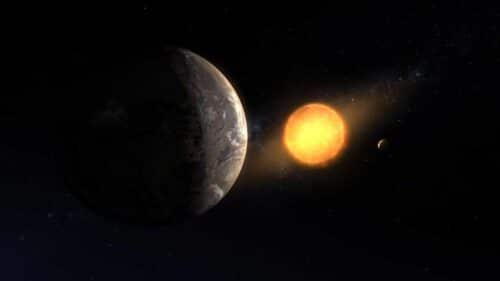The research focuses on a relatively new topic - the programming of biological life in planets orbiting red dwarfs * To verify the hypothesis, the James Webb Space Telescope, and the Israeli Ultrasat Space Telescope when they are launched, will be directed to the planets discovered by Vandel and his colleagues

A study carried out by Prof. Omri Vandel from the Rakah Institute of Physics together with Prof. Yosef Gil from the Institute of Life Sciences at the Hebrew University and in collaboration with Dr. Lev Talor from Ariel University examined the suitability of exoplanets from a climatic and environmental point of view for human habitation and life in the nearest solar systems to the Earth, and is part of an extensive project published in recent years In several scientific articles in leading scientific journals in astrophysics and astrobiology. The research will be implemented and take part in the future observations of the James Webb JWST telescope (the successor of the Abel telescope, scheduled for launch in October 2021) and the Israeli ultra-violet satellite telescope ULTRASAT (scheduled for launch in 2023).
The research focuses on a relatively new topic - the programming of biological life in planets orbiting small red suns, called by astronomers "red dwarfs". In the last decade, it became clear that these stars, which make up about 75% of all the stars in the Milky Way, are most suitable for finding planets in other solar systems with conditions similar to those of the Earth, since the vast majority of the Earth-like planets discovered (by NASA's Kepler mission) In the last decade orbiting red dwarfs. Another important advantage of red dwarfs in the race to discover life is their relatively low luminosity, which facilitates the complex operation of identifying life features in the atmospheres of their planets (using a technique similar to that used for the groundbreaking discovery of Water molecules in the planet K2-18b in September 2019).
According to the study (and other independent studies), the climate The planets near red dwarfs are strange and very different from Earth's, because they always face the same side to their "sun", similar to the planet Mercury in our solar system - so they have one side of day, the other side of night, with an eternal twilight zone in between . In a 2017 paper, Wendell and Gill proposed that life, and in particular photosynthesis, could exist in the twilight zone by analogy with summer vegetation at northern latitudes on Earth. In articles from 2018 and 2019 Prof. Wendel suggested A climate model in red dwarf planets, which allows the existence of liquid water in very different types of atmospheres than the Earth's atmosphere, resulting in a significant expansion of the habitable zone (the area where liquid water is possible on the surface of planets, in English Habitable Zone) around red dwarfs. The work is expected to be implemented in NASA's upcoming space project.
"This is a work of great importance to identify potential candidates for searching for signs of life in the planets of solar systems close to the Earth that have been discovered in recent years (among them Proxima Centauri b, the closest exoplanet to the Earth, at a distance of 4 light years). Such candidates will be the focus of the search for signs of life by the JWST space telescope that will be launched by NASA this October," Prof. Wendel explained this week.

A significant limitation to the development of life around red dwarfs concerns the bursts of intense and frequent ultraviolet radiation in the early stages of their lives, which may break down the water molecules in their planets and even erode the atmospheres of those planets. This topic is dealt with by Wendel's research proposal for the ULTRASAT ultraviolet satellite telescope project planned by the Weizmann Institute in collaboration with CALTEC (California Institute of Technology). The purpose of this research proposal is to apply the climatic theoretical results of Prof. Wendel and Prof. Gill mentioned regarding red dwarf planets, whose eruption history is relatively moderate and/or have long passed the early stages of X-ray and ultraviolet radiation eruptions, which could erode the atmosphere and their water. Will life be possible in them? Prof. Wendel's new research proposal is unique in that it complements the observations of red dwarfs that will be carried out in the ULTRASAT project by examining the theoretical climate model.
Although there is evidence that red dwarfs emit high levels of ultraviolet radiation in the early stages of their development, there is currently insufficient data on the early development of a sufficient number of red dwarfs, and we are unable to measure this radiation from Earth because it is blocked by our atmosphere. According to the researchers, the ultra-violet satellite telescope ULTRASAT will be the most suitable instrument that will be able to perform an extensive survey of red dwarf eruptions in the ultraviolet range. Also, with the help of ULTRASAT it will be possible to predict the frequency of eruptions in dwarf stars and the relationship between measurable properties of red dwarfs (such as their rotation speed related to their age) and the history of eruptions.
More of the topic in Hayadan:
- Almost every red dwarf may have a planet
- Considerable amounts of water were discovered in the Bennu asteroid, did the asteroids bring the water to Earth?
- Detecting water vapor in the atmosphere of an Earth-like planet is a big step toward discovering life in space
- The discovery that the crater on Mars where Curiosity landed was a lake increases the possibility of extraterrestrial life

2 תגובות
If the planet is locked with one side to its Sun
Probably all the water would be frozen on the cold side of it
Why find life on other stars? A waste of money and effort.
options:
1. We will find life that is stronger than us and they will take advantage of us
2. We will find a life that is weaker than us and we will take advantage of it
Don't believe? See what man does to live in our world:
For cows, fish, experimental rabbits, experimental monkeys and more.
Eli Isaac
A little about human abuse of animals:
https://eisaak123.wixsite.com/animals
A little about me:
https://eisaak123.wixsite.com/privatelessons
https://panda2all.com